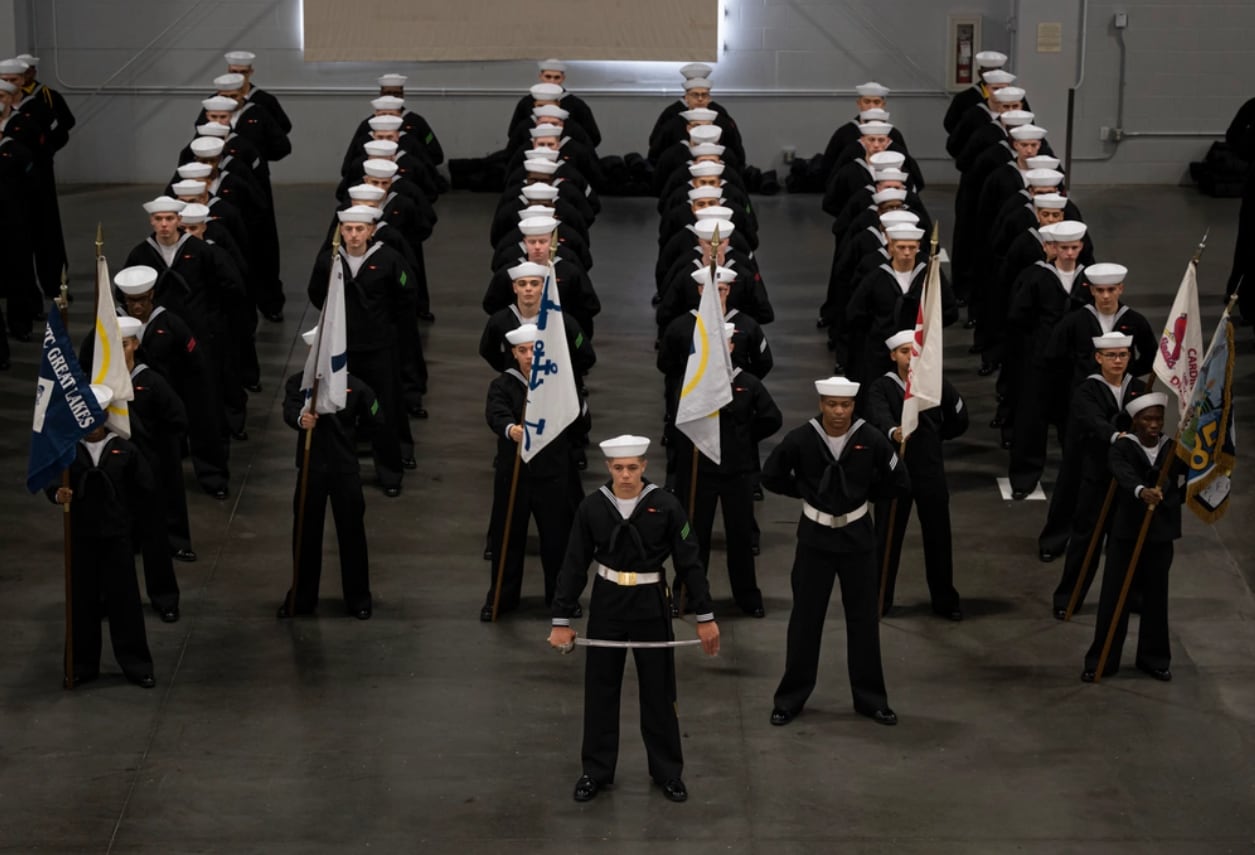As recently as June, Navy officials were still predicting that the service would miss its recruiting target for a second consecutive year, even as other services waxed bullish about their strategies for recruiting success.
But in August, Chief of Naval Personnel Vice Adm. Rick Cheeseman revealed the Navy is now expecting to exceed recruiting targets comfortably, refilling its drained delayed entry program pool and creating some breathing room for the next fiscal year. And among the ingredients of this “catastrophic success” was an unconventional decision to allow in a greater proportion of recruits who scored in the bottom 30% in testing, two recruiting-focused admirals said.
RELATED
In a round table with reporters Aug. 28, Rear Adm. Jim Waters, head of Navy Recruiting Command, and Rear Adm. Jeffrey Czerewko, commander of Navy Education and Training Command, said “opening the aperture” to bottom-scoring recruits, while not ideal, has so far not resulted in higher training attrition rates or other personnel problems.
As of the end of August, with one month to go in fiscal 2024, the Navy had contracted some 36,776 active-component enlistees and shipped 30,314 to boot camp. With an average of 4,000 contracts secured per month over the last four months, officials are now confident the service will meet its target of 40,600 contracts, Waters said.
That goal represents an increase from last year’s mission of 37,700 sailors, which the Navy missed by 7,700. Amid a push to send this flood of new enlistees to boot camp, which is happening at a rate of about 1,100 per month, the service’s delayed entry pool (DEP), which has been empty for about two years, is now packed. The start of the new fiscal year will see about 11,000 enlistees in the DEP, Waters said.
Within that new recruit population is an unconventionally high proportion of enlistees with the lowest allowable scores on the Armed Forces Qualification Test (AFQT), which is derived from the Armed Services Vocational Aptitude Battery (ASVAB). In December 2022, the Navy began accepting enlistees who scored as low as 10 out of 100 on the test, a category known as Category 4C. Below 10%, applicants are not permitted to join any military services. Using waiver authority that allows for up to 20% of these low-scoring enlistees, the Navy filled its recruit ranks with about 17%, or about 6,400, applicants who scored 30% or below.
These recruits, who the Navy then puts through its Future Sailor Prep Course, introduced in 2023 to boost academic scores and physical preparedness, are initially eligible to fill 12 of the service’s more than 80 general and service ratings. The prep course can increase that eligibility, Czerewko said.
“You put them through the syllabus, and a large number and growing percentage are able to matriculate up into the higher rate availability numbers,” he said. He cited a recent enlistee who scored below 20 on the AFQT, making him eligible for about 10 Navy jobs. His performance on the academic prep program qualified him to become an information systems technician.
“His world completely changed, and I look at that,” Czerewko said, adding that the sailor recruit had progressed through his educational years thinking he was “dumb.”
“Would I like to be out of the Future Sailor Prep Course academic syllabus? Yes, I would like not to have to do that. That’s a friction inducer,” Czerewko said. “But … quite frankly, you know, we’re completing society’s work here. We’re helping these human beings move on to the next level and showing them what the Navy has to offer them.”
RELATED

The Navy stopped recruiting bottom-tenth percentile scorers in May. It stopped accepting scores of 20% or below in August. As enlistees with scores of 20-30, known as Category 4A recruits, continue to enter the Navy, the flag officers said they’re closely monitoring their impact on training pipelines. While attrition at Recruit Training Command has historically been as high as 18%, the current attrition rate is just 8.25%, well within the target of 11% set a year ago amid recruiting shortages, Czerewko said.
“We have each human being mapped out,” he said. “Anecdotally, six of our Future Sailor Prep Course sailors were honor graduates. A majority of them take leadership positions at the start of recruit training.”
That, he said, may be a result of the “acculturating” that happens in the prep course, giving these recruits a head start on wearing the uniform and building confidence.
Likewise, attrition at the Navy’s job-specific A schools has stayed steady around 2%, he said. Recruit command leaders, he said, plan to work with Cheeseman to monitor the lower-scoring sailors’ promotion rates and other success metrics in the field.
While building up this population of typically ineligible recruits “primed the pump” for the Navy’s recruiting success, Waters said, he stressed that a total recruiting turnaround dating to his arrival at the command had led to success, including four consecutive months of meeting contracting goals.
Changes, including raising the enlistment age to 41 and eliminating the high school diploma requirement, have helped bring in a few hundred recruits, while a full-court press on shredding the medical waiver backlog and rendering waiver decisions within three days has helped stem attrition from inertia and delay.
The establishment of a “recruit operations center” to support recruiters and remove barriers to them closing the deal on a new contract has helped “remove friction” and promoted overproduction and even competition between recruiting offices for greater contract numbers, Waters said.
“We know whether we’re winning or losing minute by minute,” he said. “And we can apply resources where we’re challenged.”
Read the full article here
